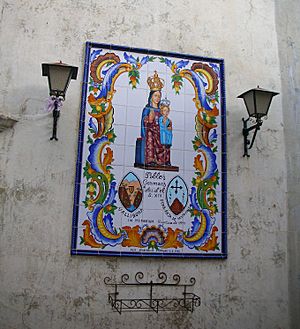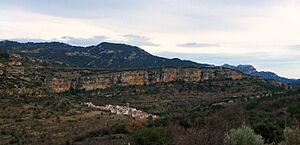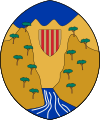Vallibona facts for kids
Quick facts for kids
Vallibona
|
||
|---|---|---|
|
||
| Country | ||
| Autonomous community | ||
| Province | Castellón | |
| Comarca | Ports | |
| Judicial district | Vinaròs | |
| Area | ||
| • Total | 91.4 km2 (35.3 sq mi) | |
| Elevation | 666 m (2,185 ft) | |
| Population
(2018)
|
||
| • Total | 75 | |
| • Density | 0.821/km2 (2.125/sq mi) | |
| Time zone | UTC+1 (CET) | |
| • Summer (DST) | UTC+2 (CEST) | |
| Postal code |
12312
|
|
| Official language(s) | Valencian | |


Vallibona is a small town in eastern Spain. It is located in the Ports region of the Castellón province. This area is part of the Valencian Community. In 2018, about 75 people lived there.
The town sits in the upper valley of the Cérvol River. It is nestled between the Serra del Turmell and the Ports de Beseit mountain ranges. Vallibona is quite isolated, far from other towns. It is also part of the Taula del Sénia, a group of towns that work together.
Vallibona has a special connection with Pena-roja (Peñarroya de Tastavins). This town is located over the hills in Matarranya. People from both towns have celebrated festivals together since the 1300s.
About 12 kilometers east of Vallibona is a small place called Sant Domènec de Vallibona. It has a church that was built in 1237. This church is close to the road that leads to Rossell.
Vallibona is also the birthplace of Florencio Pla Meseguer. Born in 1917, Florencio was a famous fighter known as "La Pastora". This nickname was given by the Civil Guard and the press.
It is important not to confuse Vallibona with Vallivana. Vallivana is a small settlement near Morella, further to the southwest.
Exploring Vallibona's Past
Vallibona was once a town under Muslim rule. This changed in the 13th century when James I of Aragon conquered nearby Morella.
How Vallibona's Population Changed
Vallibona has seen a big drop in its population over the last 100 years. In 1900, there were 1,808 people living there. By 1950, the number had fallen to 1,133. After 1959, many people moved away. They went to industrial areas like Barcelona or coastal Castelló Province.
Young people also stopped traditional farming, like raising sheep and goats. Life in rural Spain changed a lot in the second half of the 20th century. These changes also caused many people to leave.
By 1994, only 104 people lived in Vallibona, most of them elderly. Today, the town earns some money from rural tourism. Vallibona becomes more lively in the summer. Many former residents return to spend their holidays there.
See also
 In Spanish: Vallibona para niños
In Spanish: Vallibona para niños



